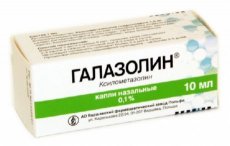Medical expert of the article
New publications
Preparations
Galazoline
Last reviewed: 03.07.2025

All iLive content is medically reviewed or fact checked to ensure as much factual accuracy as possible.
We have strict sourcing guidelines and only link to reputable media sites, academic research institutions and, whenever possible, medically peer reviewed studies. Note that the numbers in parentheses ([1], [2], etc.) are clickable links to these studies.
If you feel that any of our content is inaccurate, out-of-date, or otherwise questionable, please select it and press Ctrl + Enter.

Galazolin is a symptomatic drug for local treatment of rhinitis of various etiologies in therapeutic, pediatric and otolaryngological practice. This nasal remedy has many analogues, including Grippostad Rino, Otrivin, Dlanos, Doctor Theiss Nazolin, Influrin, Xylen, Xylobene, Rinazal, Rinonorm, Rinostop, Snoop, Suprema-NOZ, Tizin, Farmazolin, etc.
Indications Galazoline
Galazolin is recommended for use to relieve nasal congestion and improve new breathing in acute rhinitis caused by viral and bacterial infections, as well as allergic rhinitis, chronic rhinitis, nasopharyngitis. Indications for the use of Galazolin in otolaryngology are: inflammation of the mucous membranes of the paranasal sinuses ( sinusitis ), allergic sinusopathy, sinusitis, vasomotor rhinitis, in which this drug facilitates the discharge of secretions.
In addition, to relieve swelling of the nasopharyngeal mucosa, Galazolin can be used in the complex therapy of inflammation of the middle ear (otitis).
Release form
Galazolin is available in two dosage forms: as a nasal gel (in 10 g tubes) and a solution (in 10 ml vials) for use as drops.
Pharmacodynamics
The mechanism of local symptomatic action of the drug Galazolin is based on the vasoconstrictive effect of its active substance - xylometazoline hydrochloride.
This substance is an anticongestant (decongestant) and alpha-adrenergic stimulant. When xylometazoline hydrochloride gets on the mucous membranes of the nose or nasopharynx, it stimulates postsynaptic adrenergic receptors (alpha-adrenergic receptors). In response to irritation, a typical alpha-adrenergic effect occurs - vasoconstriction. Narrowing of the lumen of the blood vessels of the nose and paranasal sinuses, in turn, leads to a rapid decrease in swelling of the mucous membrane of the nasal passages and a reduction in the volume of mucus secreted. As a result, nasal breathing is restored.
Pharmacokinetics
After the introduction of drops or gel Galazolin, the therapeutic effect begins to be felt in at least 3-5 minutes and can last up to 8-10 hours. However, prolonged use of this drug can lead to a rapid decrease in the therapeutic effect.
Both drops and gel are applied locally (intranasally), and therefore are almost not absorbed into the blood plasma.
Dosing and administration
0.05% drops of Galozolin are prescribed to children over three years old - 1-2 drops in each nostril no more than twice a day. Adults and children over six years old should drip 2-3 drops in each nostril 2-3 times a day. The maximum duration of use is 14 days.
Galazolin in gel form is used in the following dosage: children aged 3-6 years - one injection into each nostril - 1-2 times a day; children over 6 years and adults - 1-2 injections into each nasal passage 2-3 times during the day.
Use Galazoline during pregnancy
It is not recommended to use Galazolin during pregnancy. If there is an extreme need, then the attending physician should prescribe this drug - with strict adherence to the maximum permissible dose.
Contraindications
Among the contraindications to the use of Galazolin are the following diseases:
Ozena (atrophic rhinitis), arterial hypertension, diagnosed atherosclerosis in severe form, diabetes mellitus, hyperthyroidism and glaucoma (angle-closure type).
Side effects Galazoline
The use of any form of Galazolin (and its analogues) can cause side effects such as burning in the nose, redness of the mucous membrane and a reflex reaction of the adrenoreceptors in the form of sneezing.
It should be borne in mind that continuous use of Galazolin for chronic nasal congestion may lead to dryness of the mucous membrane and disturbance of its sensitivity with temporary loss of smell. The possibility of increased mucous discharge from the nasal cavity, increased heart rate, increased blood pressure, headaches and insomnia cannot be ruled out.
Also, with prolonged use of Galazolin, the ability to drive vehicles and operate machinery may be reduced.
 [ 1 ]
[ 1 ]
Overdose
A possible overdose of Galazolin is determined by the following symptoms: headache, tachycardia, increased blood pressure, nausea, insomnia and anxiety.
Storage conditions
Storage conditions for Galazolin: place protected from light and out of reach of children, optimal temperature - +15-25°С.
 [ 4 ]
[ 4 ]
Shelf life
Shelf life: drops - 4 years, gel - 3 years from date of manufacture.
Attention!
To simplify the perception of information, this instruction for use of the drug "Galazoline" translated and presented in a special form on the basis of the official instructions for medical use of the drug. Before use read the annotation that came directly to medicines.
Description provided for informational purposes and is not a guide to self-healing. The need for this drug, the purpose of the treatment regimen, methods and dose of the drug is determined solely by the attending physician. Self-medication is dangerous for your health.

